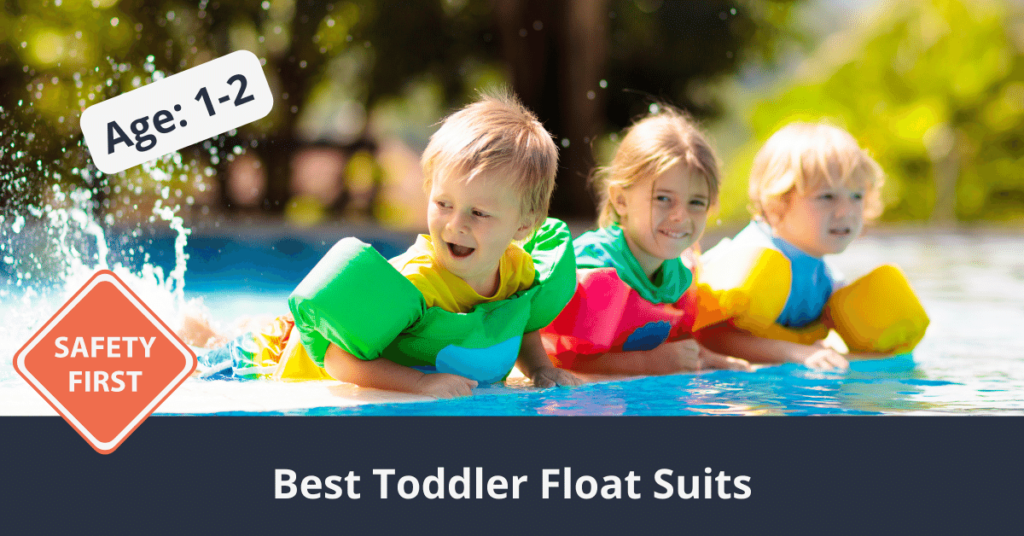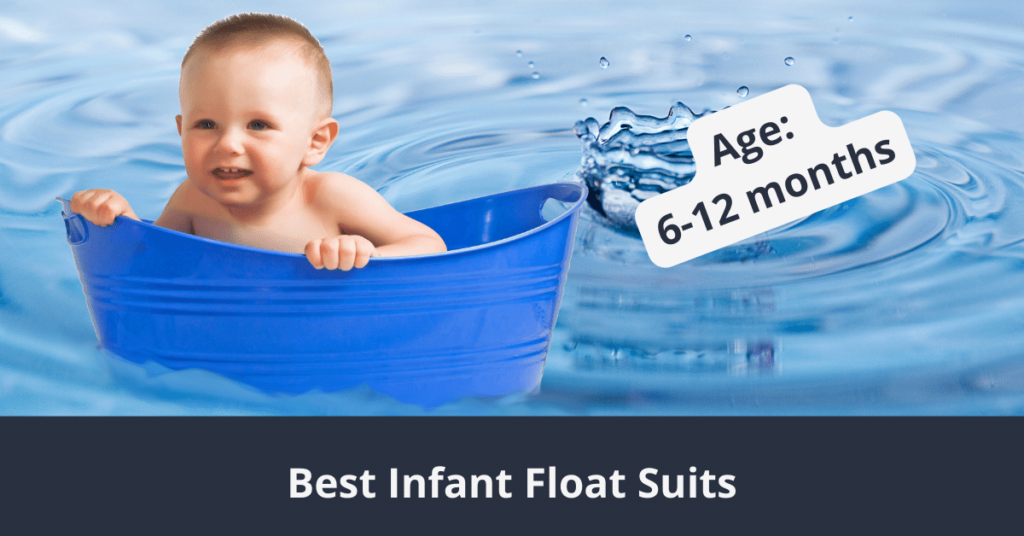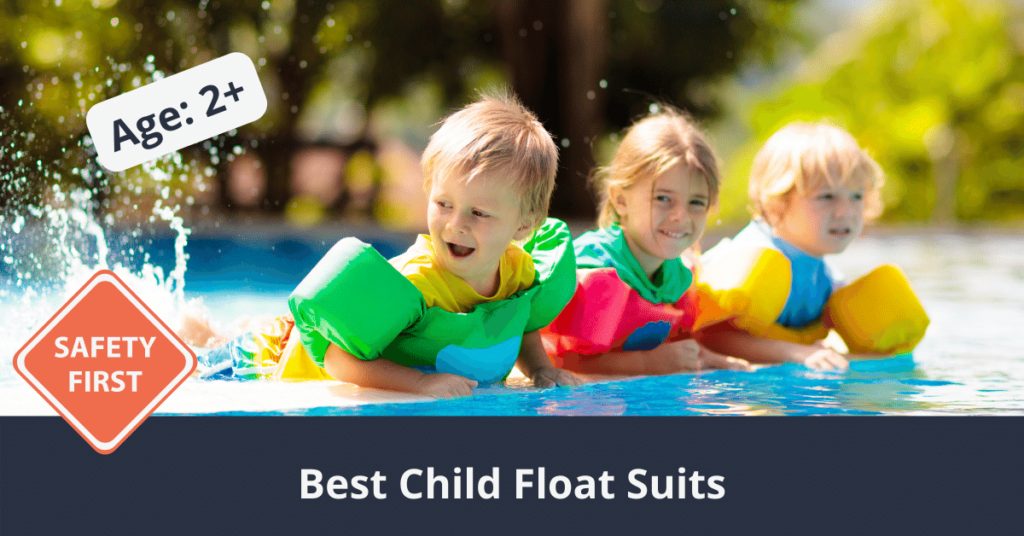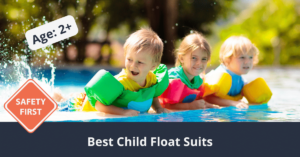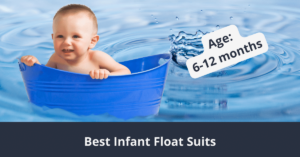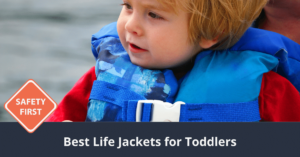Gogokids
Konfidence


- Dries more quickly than alternative choices
- Provides UV ray protection
- Dries faster than others
- Protection from UV rays
Gogokids

- Dries more quickly than alternative choices
- Provides UV ray protection
Konfidence

- Dries faster than others
- Protection from UV rays
Pools are a lot of fun, but for keeping small children safe, it’s important to get the best float suits for toddlers so they can play safely while developing the strength and stamina to swim on their own. In addition to some toddler float suit reviews, we’re going to look at some important details to consider before you go shopping.
Relevant information includes details like what materials to look at, buoyancy concerns, how to care for float suits for toddlers, and other details you should know. Before we get into the reviews, however, there’s one important point to address: the types of products we’re looking at.
This toddler suits guide focuses specifically on float suits for toddlers who are 1-2 years old. You will find some amazing swim float suit for 1-2 years boy or girl.
The toddler-sized swimsuits have one or more (usually many more) detachable flotation devices like small airbags. These allow you to adjust exactly how buoyant the suit is and encourage your child to develop the skills needed to float on their own.
Always remember that float suits for Toddlers are not life jackets, and you should never allow toddlers to play in a pool without supervision.
Everything you will learn here
- The Best Toddler Float Suit Reviews (Updated 2023)
- 1. Best Colorful Float suit for Toddlers: Gogokids Float Suit
- 2. Float for Toddler with Best Accessories: Wowelife Baby Float Suit
- 3. Best Mid-Range float suit for toddlers: CH&Q Kits Float Suit
- 4. Best Sleeved Suit: Splash About Happy Nappy Swimsuit
- 5. Best One-Piece: Swimline Blue Lycra, Small Size
- 6. Best Stretchy Suit: Konfidence Floatsuit
- 7. Best Jacket Style Suit: iToobe Swimming Jacket
- Float Suits for Toddler: Comparison Chart
- Float Suits for Toddlers Buyer’s Guide – Making Sense Of It All
- Types Of float suits for toddlers
- How Much Flotation Do Float Suits for toddlers provide?
- Where Did All The Air-Based Flotation Devices Go?
- Benefits Of Toddler Flotation Suits
- Drawbacks And Disadvantages of float suits for toddlers
- Maintenance of float suits for toddlers
- Safety Tips for float suits for toddlers
- Prioritizing Value: Dont’t be cheap when you buy float suits for toddlers
- Wrap Up of best picks for float suits for Toddlers
The Best Toddler Float Suit Reviews (Updated 2023)
The following are our top float suits for toddlers for 2023. While this list is numbered, the numbers are not a ranking, and the reviews are not in any particular order.
1. Best Colorful Float suit for Toddlers: Gogokids Float Suit
- More Safety - The kids floatation swimsuit features adjustable buoyancy sticks and allows children full use of their arms, promoting safe and comfortable swimming for children.
- Comfortable Fabric - The toddler float suit is made of high-quality, quick-drying, and comfortable materials, ensuring a pleasant wearing experience for children.
- Sun Protection & Confidence Building - Gogokids floatation bathing suit provides UPF 50+ sun protection, ensuring the safety of children's skin. It also helps build water confidence through the adjustable buoyancy sticks, allowing children to swim more confidently and safely.
Gogokids may not be a household name, but their toddler float suit is easily one of the most flexible and diverse options currently on the market. Available in a wide variety of colors and sizes, this float suit uses removable buoyancy foam that’s mainly located on the back to encourage good swimming postures.
Foam is significantly better than air-based flotation because there’s no risk of it suddenly losing effectiveness over periods of extended use. This body-covering swimsuit also includes sleeves and shorts, allowing it to function as a full-body swimsuit suitable for many different environments.
The one major flaw of this swimsuit is that it’s not flexible enough to support a difference of more than a few inches or pounds. Kids grow quickly, so it’s entirely possible that one of these swimsuits will last a single season at most. Fortunately, they aren’t too extensive, but the sizing limits are something to keep in mind when you’re shopping.
Pros:
- An impressive number of color options
- Uses removable foam instead of airbags
- Reasonably affordable
Cons:
- Narrow size limits
- Occasionally sends the wrong print
- You may need to buy two for the same season
2. Float for Toddler with Best Accessories: Wowelife Baby Float Suit
- Design Theme: Wearing toddler float suit with arm bands, perfect for building confidence to swim,providing more balance for kids in pool and keep safe and avoid losing balance
- Quality: Fully tested for quality and safety
- Size Reference: Float suit suited for kids of 1-4 years old and for choosing the perfect size, please check data of suits chest length and height, baby height and weight in Picture Reference. If you have any question, please feel free to contact us
Wowelife’s float suit is a fairly standard design with holders for eight foam float sticks, four each on the front and backside of it. The suit itself is 82% polyester fiber and 18% elastic fiber, which gives it a comfortable level of stretch to support the needs of growing children. This suit is available in three sizes, with the small size being the most suitable for 1-2-year-olds.
Unlike many other suits, this product also comes with a pair of inflatable armbands. Sadly, they’re not foam, but they offer additional support for children who are still learning how to swim and can provide that extra bit of help and support.
This particular suit offers outstanding mobility, too. While it doesn’t have the full-body covering of the first product on this list, it does allow a full range of motion for toddlers who are still learning how to swim. That, in and of itself, is a great quality.
However, this suit does tend to have some trouble keeping children upright if they lean too much, so it may not work for all swimmers.
Pros:
- Comes with armbands for extra help
- Removable buoyancy sticks make it easy to adjust the effectiveness
- Offers an excellent range of motion
Cons:
- The arm floats limit mobility
- It’s not as effective at keeping people straight up and down
- Requires a long soak for washing
3. Best Mid-Range float suit for toddlers: CH&Q Kits Float Suit
This durable nylon suit comes in sizes suitable for children from 1 to 10 years old, which makes it extremely practical for getting suits in the same size if you like it and want additional copies as your child grows.
Like most toddler pool suits, this outfit includes spaces for eight removable floats (included with the suit), allowing for extra customization as children learn how to swim. The main feature that sets this model apart from some others is the legging area, which functions as a pair of comfortably tight shorts that encourage a free range of movement.
Nylon is somewhat better at stretching than polyester, so this product is easier for many children to put on. However, it’s not quite as good at resisting damage from chlorine, so these suits are worse for long swimming sessions in pools.
Outside of its other qualities, this flotation suit is available in several different patterns suitable for both boys and girls, which makes it easier to find something that’s either very visible or looks good on your child.
Pros:
- It stretches well, and it’s easy to put on
- The size ranges make it easy to upgrade to the next level as your child grows
- The leg areas encourage freedom of movement while reducing exposure to UV rays
Cons:
- Not quite as good in chlorinated pools as some other float suits for Toddlers
- Moderately expensive compared to other products
- Some versions have ribbons on them, which we generally discourage
4. Best Sleeved Suit: Splash About Happy Nappy Swimsuit
- Removing restriction of arms and legs by supporting the body in a natural swim position and leaving arms and legs free to kick and splash
- Adjustable to size and encourages water confidence by adding or removing floats, conforms to European safety standard, en 13138-1: 2060
Skin coverage is important for children, especially if they’re spending hours playing in a pool. This is a rare float suit that has both short sleeves and leggings, and like our other good options, it’s available in a variety of colors to help suit personal preferences.
The extended arm coverage and high neckline are the main standout points of this float suit, which is otherwise similar to most other products on the market. Notably, it features the usual eight spaces for floats, as well as a simple slide-in.
The major downside of this product compared to many of the others on this list is its lack of options for older children. While some suits offer sizing options that go all the way to ten years old, this suit only goes to about six years old, which means you may need to switch brands if your child still wants, or needs, flotation aids when they’re that old.
Pros:
- Covers more skin than most other float suits for toddlers
- Has a variety of colors
- Conforms to European safety standards
Cons:
- Can be a little hard to get in and out of
- Most useful for children who are already confident in the water
- Not quite stretchy enough to fit all sizes in the listed age range
5. Best One-Piece: Swimline Blue Lycra, Small Size
Swimline’s 9892B floating swim trainer is an unusual product for this category in that its flotation aids aren’t detachable. Unlike many other products, where you can add or remove them as needed when children grow, this provides solid and reliable flotation help at all times.
We think flexible suits are fundamentally better than products like this one. However, variety is also important when evaluating products, and there are a few advantages to this design. The most obvious one is that there’s no chance of loose fabric coming off from an entire section.
The one-piece design is also more durable than swimsuits with thin fabric stitched on top of the base suit, so you can expect it to last for the entire time your child is small enough to use it. This swimsuit is even durable enough to last through a second child if treated reasonably well, which can help defray some of its higher costs.
Keep in mind that, just like the other float suits for toddlers here, this product is not the same as a lifejacket and should not be treated as such for any purpose.
Pros:
- One-piece design ensures you won’t lose any components
- Suitable for extended use in pools, lakes, or ocean water
- Particularly good for teaching children how to swim
Cons:
- Tends to roll children onto their stomachs
- Focuses pads on the upper chest instead of throughout the body
- Intended for boys, rather than being unisex
6. Best Stretchy Suit: Konfidence Floatsuit
- OVER 20 Years EXPERIENCE: Konfidence Floatsuits benefits from over 20 Years’ experience. We have become an industry leader in child swimming, used by swim teachers and swimming schools across the world. The most recent guidelines from Swim Wales are for the use of fixed/worn buoyancy aids. All Konfidence Floatsuits are Class B: fixed/worn by the swimmer. Particularly useful in pools with varying depths and with social distancing being observed by the teacher.
- STYLISH: Our floatsuits are designed with a chic traditional swimsuit style in mind.
- EASY TO ADJUST BUOYANCY: allowing you to tailor to your child’s weight to ensure correct support in water, giving you the confidence and security in knowing they will always have the buoyancy they need.
Sometimes stretchiness is the most important factor in a float suit. Young children come in an impressive variety of shapes, and what fits some children won’t necessarily fit others. For those cases, the Konfidence Floatsuit offers a mix of 82% nylon and 18% elastane (spandex), which makes it significantly better at stretching than most other options.
Aside from its focus on stretching, this is a rather standard float suit option, with eight compartments for buoyant foam. The suit itself is available in several colors designed to mimic traditional swimsuit fashion, while covered areas benefit from 40+ SPF protection. That’s a bit lower than some other swimsuits, so if your child is sensitive to light, consider another suit.
One of the less-obvious features of this product is the fact that it dries faster than many other fabrics. This is particularly helpful when you’re on a tight schedule or simply want to finish packing up so you can turn your attention to other things.
Pros:
- Stretches better than other options
- Dries faster than many other float suits for toddlers
- Decent, although not amazing, protection from UV rays
Cons:
- Can appear partially see-through when wet
- Tends to push children forward
- Often a little large for children on the younger side of one year old
7. Best Jacket Style Suit: iToobe Swimming Jacket
- 【Kids-Friendly】Designed with superior soft and flexibility materials, more smoother, providing better protection for toddler/kid's skin, and printed with cute and beautiful patterns to catch baby's eyes.
- 【Strong Buoyancy】This swim jacket enployeed with high-density and thicker premium foam inside, which can provide strong buoyancy to keep toddler's head floating on the water, makes toddler to swim and play more better and safer.
- 【More Application】The hot summer is on the way, this toddler floaties can not only be used for toddler swimming training, but also be used for playing on the beach, swimming pool, water park, and more, which will deliver tons of fun for you little one.
Full-body float suits for toddlers are easily the most popular design, but they’re not the only design on the market. This float jacket only covers the upper body, but it’s easy to wear on top of another swimsuit. This won’t stack with other flotation suits, though, so don’t expect to double-up for an imitation life jacket.
There are a few points to consider about this product compared to regular float suits for toddlers. First, the top here is bulkier than most other top coverings, which will somewhat reduce their range of movement. This is good for play and some teaching, but it isn’t as good for full swimming.
Second, this product focuses its flotation support around the arms, rather than around the torso. This is an unusual design, but it can help children who struggle to fit comfortably in torso-focused suits.
iToobe’s swimsuit is primarily made of neoprene, which gives it added warmth in the pool. It can run hotter than some other materials, so be aware of your child’s temperature and hydration while they’re wearing it.
Pros:
- The unusual design supports children who can’t wear other swimsuits
- Excellent 50+ UPF protection
- Comes with an extra zipper covering to prevent it from harming the user
Cons:
- Does not let you adjust the buoyancy
- May not provide enough buoyancy for some users
- Arguably not as good as simply getting a proper life jacket
Float Suits for Toddler: Comparison Chart
| Product Name | Price | Fit For (Years) | Colours | Distinct Features |
|---|---|---|---|---|
| Gogokids Float Suit |  Check Price | 1-8 | Blue, Red, Yellow | Made by 80% polyamide and 20% elastane, lightweight and quick-drying |
| Wowelife Baby Float Suit |  Check Price | 1-3 | Blue, Light Pink, Sea Blue, Yellow | Made of 82% polyester fiber and 18% elastic fiber for better elastic and more comfortable |
| CH&Q Kits Float Suit |  Check Price | 1-10 | Blue, Dark Blue, Pink, Purple, Red, Rose, Yellow | Leg areas encourage freedom of movement while reducing exposure to UV rays |
| Splash About Happy Nappy Swimsuit |  Check Price | 0.25-3 | Pink, Blue, Green | Conforms to European safety standard, en 13138-1: 2060 |
| Swimline Blue Lycra, Small Size |  Check Price | 1-3 | Blue | Great to use while learning to swim, Foam lining provided buoyancy |
| Konfidence Floatsuit |  Check Price | 1-5 | Pink, Blue, Cayan, Navy | 82% Nylon / 18% Lycra, conforms to international testing standards |
| iToobe Swimming Jacket |  Check Price | 1-7 | Blue, Pink | It is made from super soft UPF50+ neoprene, that is comfortable for your child to wear in and around the water |
Float Suits for Toddlers Buyer’s Guide – Making Sense Of It All
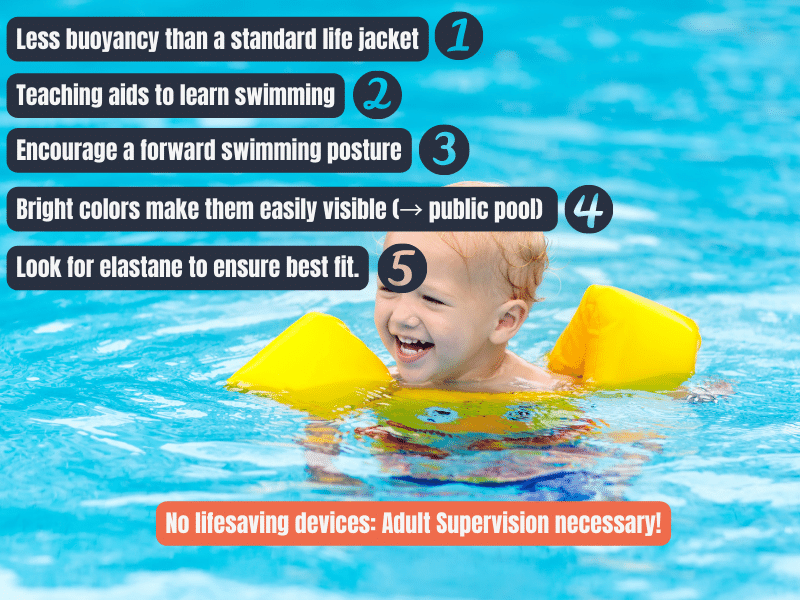
All of the products listed above are high-quality options that serve their purpose well, but just like other types of products, not all products are ideal for all buyers. Here are the things you should know before you start shopping for a kid’s float suit.
Types Of float suits for toddlers
Float suits for toddlers come in two primary styles. The first, and by far the most popular, style is a full-body swimsuit with compartments for eight foam tubes that can provide buoyancy. The purpose of these is to let you adjust the overall flotation power of the suit for different situations.
The other common style is permanent flotation capabilities. These have the flotation foam sewn directly into the suit, which prevents losing the foam but also removes the flexibility.
How Much Flotation Do Float Suits for toddlers provide?
That depends on the suit, but most provide significantly less buoyancy than a standard life jacket. Float suits for toddlers are not designed to be lifesaving devices, and may not be enough to keep a child on the surface unless that child is actively trying to remain on the surface.
The primary reason for this is that most float suits for toddlers are teaching aids that help teach children how to swim. They encourage a forward swimming posture rather than keeping a child’s head above the water, and, in general, they are not suitable for other purposes.
This is why you should lever let toddlers swim unsupervised even if they’re wearing a float suit. It will not protect them, and may even be dangerous if used improperly. They’re great products when used well, but like everything relating to pools, you should only use them for their intended purposes.
Where Did All The Air-Based Flotation Devices Go?
If you pay close attention to flotation aids, you’ll see that most products for children younger than one-year-old and some proper life jackets rely on air or other gases for flotation. However, suits for children older than one year are almost exclusively foam-based.
The primary reason for this is that float suits for toddlers are not supposed to provide too much flotation. Air always rises to the tops of pools, and it’s also difficult to adjust an air-based float suit to provide some buoyancy without outright floating on the top of the pool.
Foam, in contrast, is significantly easier to manage. The most popular suit design has eight individual pouches for foam, so you can adjust it as your child grows more comfortable in the water. Even products with fixed amounts of buoyancy can keep that amount low enough that the suit does not become a life jacket.
Benefits Of Toddler Flotation Suits
There are several benefits to using toddler flotation suits over other products, particularly life jackets. Keep in mind that regardless of the type of product you want to use, you should never let a toddler into the pool without some form of flotation support. Also, toddlers should stay within arm’s reach of an adult at all times.
The first benefit is that toddler flotation suits are excellent teaching tools. Many of them help push children into a good swimming posture, which helps them understand how they should tilt and move their bodies while they’re in the pool.
Flotation suits also discourage relying too much on equipment. They aren’t life jackets and won’t keep a child above the waterline with no additional work required. Instead, they simply help compensate for the lower amount of muscle and stamina that toddlers have when compared to older, more-developed swimmers.
The main goal is for toddlers to enjoy their time in the pool, but also to understand that they must actively manage their safety while they’re inside it. Thinking they can relax and let their equipment do all the work is potentially dangerous, and it’s better to avoid teaching them things like that.
Finally, toddler flotation suits tend to be bright and easily visible. This is particularly important when you’re playing in a public pool environment, where the crowd of other people can make it harder to keep track of your own kid. Visible designs are a safety component, and we value that more than anything else.
For more information on why it’s so important to wear and use a flotation suit, check out our interactive resource for US drowning statistics, worldwide drowning statistics, and drowning prevention strategies.
Drawbacks And Disadvantages of float suits for toddlers
There are no disadvantages significant enough to avoid using some form of flotation aid for children going into a pool. The only exception is if the pool is no more than waist deep at any point. However, there are individual characteristics that can make products better or worse than their competitors. Here are the disadvantages of some float suit types.
The main value of the traditional eight-compartment design is also its biggest flaw because removable foam is easy to lose. Pets may grab and move them, thinking they’re toys, and small children may do the same because they like seeing things float on top of the water.
This isn’t as much of an issue when you’re ready to remove some foam and push your child towards entirely supporting themselves, but losing the foam early could render the suit useless, or at least less useful until your child grows a little more.
Next, many suits in this range have limited sizing options. The huge majority of float suits for toddlers are one-size-fits-all designs that work for children with average proportions. However, any child that’s outside narrow height and weight guidelines may have a difficult time fitting into specific suits.
The only real way to address this is to look for suit materials that stretch better and can fit a wider variety of body shapes. Elastane is useful in swimsuits because of its outstanding degree of stretchiness, and float suits for toddlers with 15% or more elastane are generally better at fitting different body shapes.
From there, artificial fibers usually work much better than natural fibers. Natural cloth has a tendency to get heavy and uncomfortable, which is always an issue for swimsuits but never more so than with children who don’t have the strength to compensate for this.
Most float suits for 1-2-year-olds are exclusively “small” sizes in a product line. You probably won’t find medium or large variants for this age group, much less 2xl, 3xl, 4xl, 5xl, or even 6xl like you can for adult swimsuits.
Finally, some float suits for toddlers can impede a child’s range of motion. If you look closely, you’ll see that most traditional float suits for toddlers keep the buoyancy sticks around a child’s torso, roughly from their ribs to their belly. This placement is designed to minimize their interference with a child’s arms, encouraging an easy and natural swimming motion.
However, the float sticks can still interfere with some types of movement. Other float suit designs often have thicker pads around the shoulders and restrict the range of motion even more. Ultimately, the goal is to help children transition away from needing a float suit before they learn any bad habits.
Maintenance of float suits for toddlers
As swimwear, most float suits for toddlers don’t need too much maintenance. Or, rather, can you imagine anyone buying a swimsuit that did? While we’re not interested in high-maintenance options here, there are a few things you should keep in mind when deciding which products to buy.
First, the traditional eight-bar design usually has the pouches sewn directly into the swimsuit, and these are weaker connections than used elsewhere. You should check the swimsuit after each use to be sure the pouches are still tight.
Next, you should wash the swimsuit after each use, according to the manufacturer’s directions. You may need to remove the foam before putting it through a washing machine. Alternatively, some suits only need you to spray them with clean water and then wipe them down before hanging them up to air dry.
Failure to perform these basic cleans could result in float suits collecting chemical residue, developing smells, or even molding.
After cleaning and drying a toddler’s float suit, store it in a dry area away from direct sunlight. Most swimsuits tolerate sunlight well, but daily cycles of direct heating and cooling could lead to the swimsuit fading and wearing out much faster.
Safety Tips for float suits for toddlers
While most float suits for toddlers are easy to put on and take off, especially because they’re designed to work with children who may not be compliant, there are a few safety tips to keep in mind when using them.
First, and we cannot stress this enough, flotation suits are not life jackets. They are not recognized by the U.S. Coast Guard as life-saving devices and cannot independently support a child above the water. This is why you should never let toddlers play in a pool unsupervised.
While adult life jackets are often suitable for people over 200 pounds, over 250 pounds, and sometimes even over 300 pounds, most float suits for toddlers can’t support weights above 30 or 40 pounds. If your child is outside the standard weight range for their age, then consider buying a life jacket instead of a float suit.
Next, occasionally check the flotation foam to ensure it’s still in good condition. Most foam is durable and will last a long time as long as it’s not abused (such as by pets chewing on them). However, toddlers may start squeezing the foam like it’s a toy, eventually breaking it apart and drastically reducing the effectiveness.
Finally, if you use the suit more than a few times in one season, check for signs of general wear and tear. Most float suits for toddlers will be fine for the one or two seasons you can use them, though if your child is in the pool every day, you may need a replacement anyway.
Manufacturing defects happen, and it’s always better to check the suit for problems than to assume there aren’t any.
Prioritizing Value: Dont’t be cheap when you buy float suits for toddlers
In this context, value does not refer to the price of a flotation suit. Instead, it refers to any positive attributes that make a particular product worth buying, especially in comparison to its competitors.
We value safety more than anything else for the products we reviewed. A suit that’s visually attractive but fundamentally bad at its job is a much worse product than an ugly but effective swimsuit. This is particularly true for flotation suits since many of them are only supplementary aids for learning to swim, not toddler life jackets as some people expect them to be.
While all final shopping decisions are yours, we strongly encourage prioritizing safety the same way we did. Toddlers will outgrow a float suit in two swim seasons at best, and you can always get a different suit when they’re older.
A safe flotation suit is one with few areas that can get caught on hooks or branches, a durable exterior, and enough buoyancy to be useful. Adjustable fits are nice but extremely rare, so don’t expect to find any of those.
Outside of the safety aspects, the value in a toddler’s float suit is a balance of its price, appearance, and any accessories that come with it. Some float suits for toddlers come with inflatable armbands or a head cap, both of which can cover additional skin and help protect children while they’re in the water.
There aren’t many premium options in this product category that are worth considering. You can only take permanent or removable foam so far with a swimsuit, and almost every product with considering retails for less than $50. We don’t recommend paying more than this unless you find an exceptionally good product.
Wrap Up of best picks for float suits for Toddlers
At this point, you know much more about the types of products on the market and what features or qualities can separate them from each other. In summary, however, most traditional float suits for Toddlers are distinguished by their choice of materials, while alternative designs usually offer more flotation power or flexibility for different body types.
Most children love playing in the pool, but they may be hesitant to dive in if you suddenly start putting them in a new suit and gently drop them into the water before they’re even done processing the change. Instead, consider introducing your child to the swimsuit by putting it on and having them wear it several times before they go into the pool with it.
Don’t forget to think long-term, either. Many manufacturers sell toddler float suits in different sizes, and you may be able to get larger versions of the same suit until your child is five, eight, or even ten years old. This is particularly useful if swimming is a part of your lifestyle since you won’t have to change to a new brand every year or two.
Finally, consider donating the float suit once you’re done with it. Toddlers will outgrow any swimsuit you buy them, and donating the suit when you’re done is a great way to support your community.
Last update on 2024-04-19 / Affiliate links / Images from Amazon Product Advertising API

